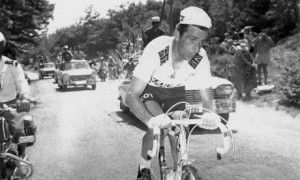Recently the topic of The Rules has popped it’s head up in a couple of discussions over on the book of faces. I should say up front, for people who worry about these things, that The Rules aren’t real rules. They are meant to be a tongue in cheek guide to how one should present oneself and one’s bicycle if one wishes to be seen as a ‘real’ cyclist (what is a real cyclist? Good question, and I’ll come back to that).
The rules are much beloved amongst our lycra clad brethren, both as a source of fun and spiritual guidance. I say this fondly for I am not unfamiliar with the stretchy wonder-material myself. However, these days I am an audax rider rather than a racer and we’re a non-conformist bunch who don’t worry about rules too much.
It is Rule 5 which has been causing controversy on our facebook group. Rule 5 simply says ‘harden the heck up’. Except it doesn’t say heck, but this is a family forum. It is illustrated with a humorous video of cuddly ex-Australian serial murderer Mark ‘Chopper’ Read swearing at a series of hipsters (hurrah) and children (boo).
If one does the sort of cycling that involves ‘challenges’ - going very fast or very far then Rule 5 will inevitably come into play sooner or later. There will be times when legs are jellied and flesh is weak and one has to ‘harden the heck up’ to get home. But cycling doesn’t have to be like that. Some of us like challenges and choose to cycle like that, but it doesn’t have to be so. Cycling can just be a simple and gentle way to get around or have a day out in the country if that’s how you prefer it.
Perhaps the most famous adherent of Rule 5 is the much-lamented Tom Simpson. Simpson was the first british professional cyclist to wear the yellow jersey in the Tour de France and to win the World Road Race Championship. However, Simpson’s willpower exceeded his stamina and he rode himself to death on the baking slopes of Mont Ventoux in July 1967. So, Rule 5 perhaps needs to be treated with a little caution.
This brings us, in a roundabout way, back to the question of which is the real cyclist? Is the one who dons lycra and cycles 200km or more any more of a cyclist than the person who just uses their bike to get around? I think the key word in that question is actually ‘person’. In the end we’re just people on bikes and it doesn’t matter who is a ‘real cyclist’. We’re all frail human beings, however tough we like to think we are we.
The context in which Rule 5 has raised it’s head in discussion on our Facebook group is urban cycling. Specifically that cyclists should stop complaining about being forced into conflict with traffic, ‘harden the heck up’ and get on with it. It’s fair to say that a number of people were uncomfortable with this concept.
The reality is we live in a city which desperately needs more people to ride bikes. Ordinary people to ride ordinary bikes in ordinary clothes to do ordinary things. That’s what a bike is in the end. A brilliant tool for getting around and doing other things. In Portsmouth we desperately need more people to make more ordinary journeys by bike to make themselves and the city a healthier, wealthier place to live. This is what A City to Share is about.
Cycling in a city is a fabulous way of getting around and needs to be accessible to everyone. As soon as you say ‘rule 5’ in that context you’re effectively saying that cycling is only for the strong, those who laugh in the face of danger. I don’t think that’s helpful.
Rule 5 is not helpful in weaving the fabric of society. If we applied Rule 5 to all social problems there would certainly be no NHS. People would just ‘harden the heck up’ instead of flopping around in hospitals all day. Take it to its logical conclusion and we’d all just be cavemen.
Rule 5 is useful if you’re halfway up an alpine pass with the Tour De France about to slip through your fingers. Rule 5 is not useful if you want your children to be able to cycle to school. If you’ve had a conversation in which an apparently redoubtable adult tells you that they’re too frightened to cycle then it’s obvious that Rule 5 is not the answer. We need the design of our roads, the way we use our roads and the way we enforce the law on our roads to change.
So, by all means, read ‘the rules’ if you like that sort of thing. If you go out for long rides have a giggle about them with your chums. I certainly have. But please don’t mistake them for real life.

